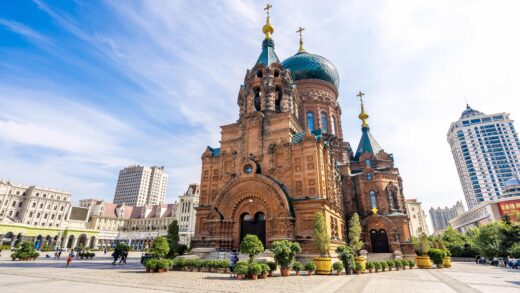The article was first published in onely Planet China magazine, Issue 12/2021.
This English version was translated from the Chinese original with DeepL, with the manual correction of some obvious mistranslations. I apologize for any mistakes made by this AI translation tool.
This is the second part of the article. Click here to read the first part.
2PM: A winter adventure over the Biluo Snowy Mountain
After turning back along the Lancang River from Cizhong, We crossed the bridge at the junction with a sign saying “Gongshan”, and the atmosphere was suddenly tense. There were signs that say “Snow”, “Rockfall”, “Landslide”, or even the simple word “Danger”. A series of warning signs, like the rails on a hurdle course, are placed one after another in the road, and the driver must carefully go around each of these alarming signs before proceeding, never ignoring their contents.
I am not an adventure-loving traveler. As British explorer Dervla Murphy said, Escapists are ultracautious. I had no choice but to cross the Biluo Snow Mountain in the dead of winter at the end of December via the dangerous Deqin-Gongshan Highway, because it was the only route from Deqin to Gongshan, the only way for me to complete the “Crossing of the Four Rivers”.
Yet I must also admit that Camus’ phrase A place that reeks of fear is sometimes enchanting also applies to me. So when I was actually driving down this uncertain road, gripping the steering wheel with both hands and feeling the bumps of the wheels over every stone, an inexplicable excitement suddenly overtook me.
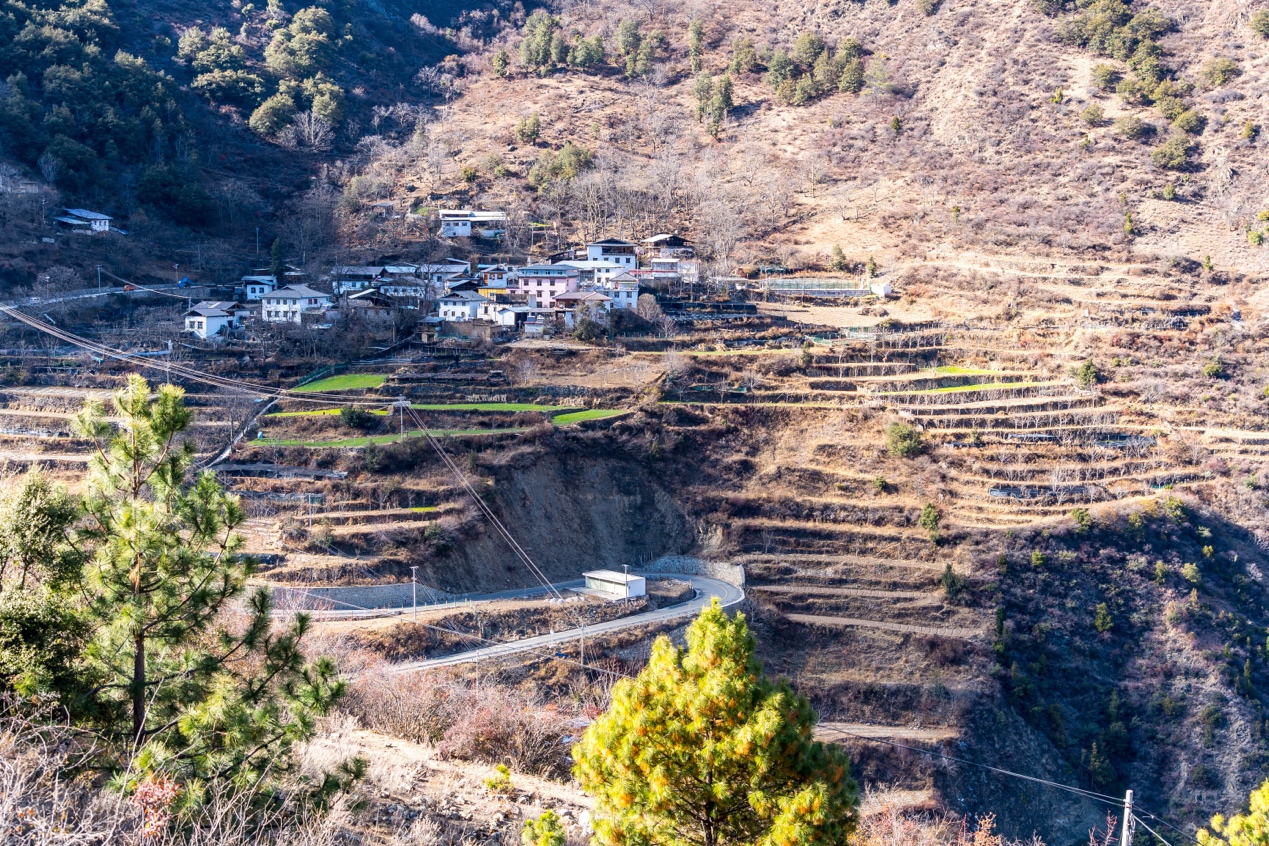
The road, just over 90 kilometers, was built in 2007 and took 12 years to build until it was officially opened for trial operation a year ago in October 2019. And just a year after it opened to traffic, it has experienced two prolonged road closures in winter snow and rainy season landslides, with less than six months of actual access. Before I left, I called all the traffic departments in Deqin and Gongshan counties on both sides of the highway, and even in the Diqing and Nujiang prefectures to which they belong, to ask if the road was closed early due to snow, as it had been in December a year earlier. All operators told me that they had not received any notification of this. Anyway, no news is good news.
Despite prior mental preparation, the road was not at all as treacherous as one might expect. It climbed quickly above the snow line, but thanks to excellent maintenance, apart from the occasional cave-in patch, I spent the majority of the time speeding along on nearly new, flat roads, even stopping to take pictures of the yaks lazing in the roadside meadows.

The only thing that vaguely disturbed me was that I barely encountered any oncoming traffic along the way. Even when the occasional one did come, it was one of those sludge-covered, overbearing, hardcore SUVs. The drivers who saw me always either gave me a surprised look or simply gave me a thumbs up as a sign of encouragement. I wasn’t sure why they did it, but it didn’t look like a good sign.
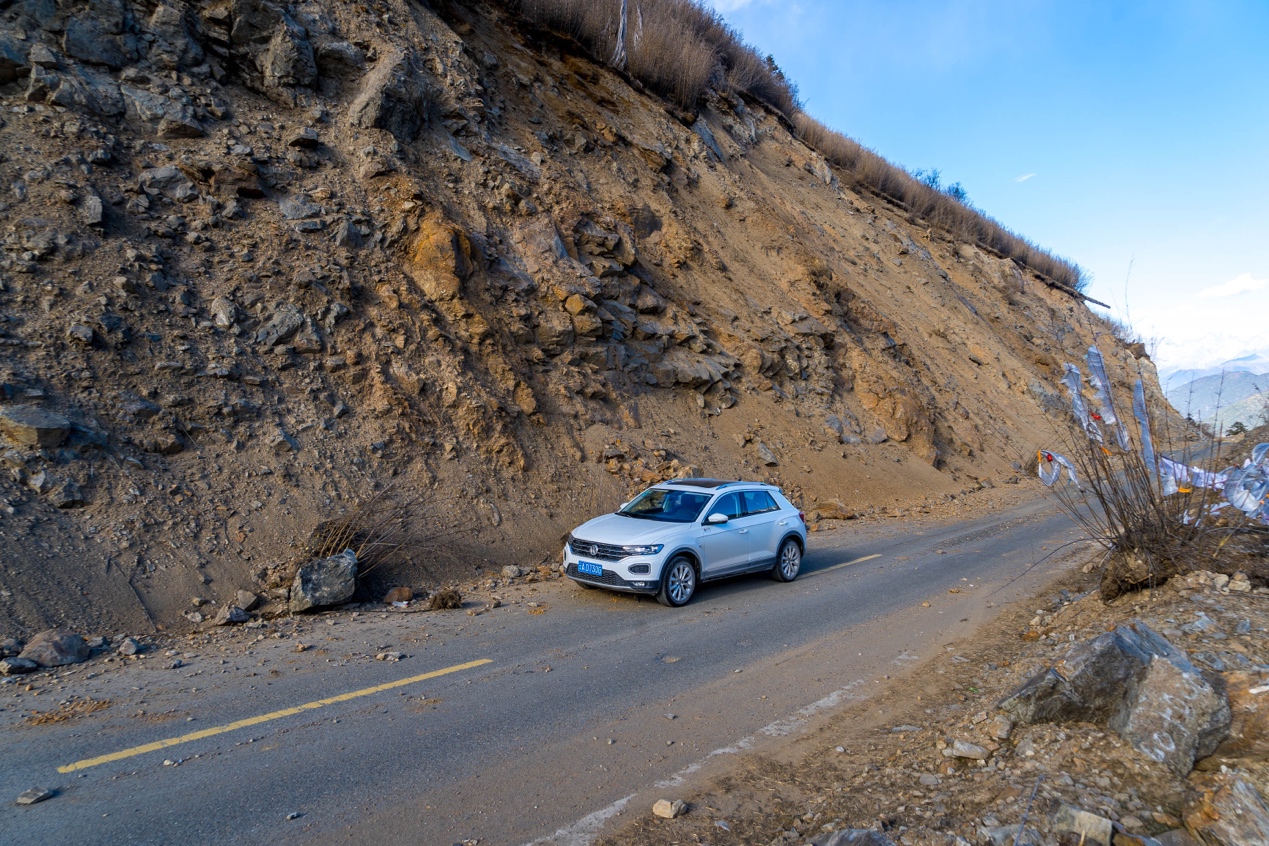
The road becomes progressively more rugged as it gains altitude, and by the time we reach the highest point of the road, the 3,882m Peacock Mountain Pass, there is only barely any dirt road left on the year-round permafrost. On the whole, however, the first half of the road is easy and enjoyable, not enough to be called “dangerous”. Common sense dictates that the second half of the road should be in similar condition, so my heart was half in my mouth.
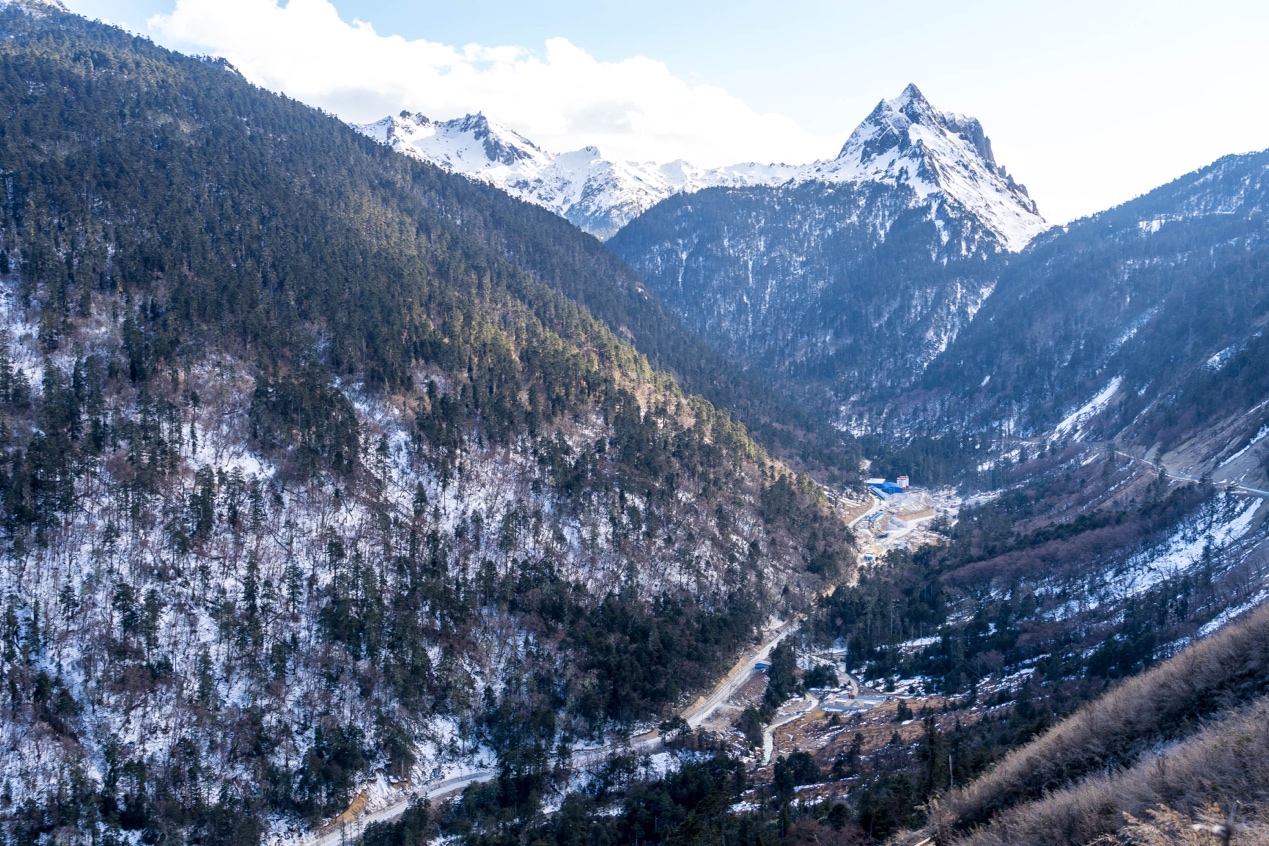
The pass is still fluttering with multicoloured sutra streamers, which are dancing and crackling with the whistling mountain wind. Behind the streamers is more than 4300 meters above sea level, the peaks of the peacock mountain, less than 500 meters straight from the road, the snow-capped mountains seem to be within reach. On the other side of the pass, the cedars stand firm in this supposedly barren alpine area, their dark green color reflecting the gray and white rolling hills in the distance.

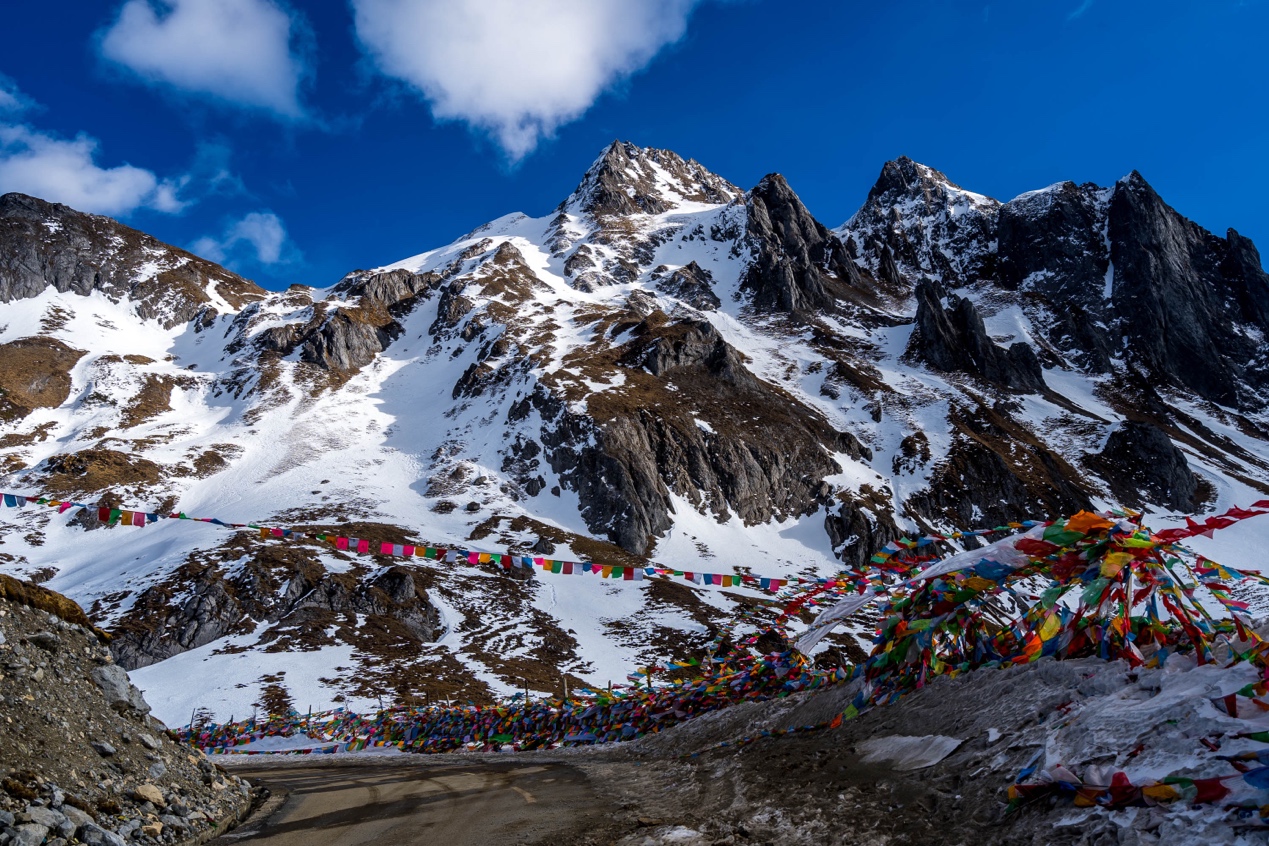
A couple of SUVs were waiting here for tourists who were doing their best to take pictures. I asked one of the drivers if the road ahead was passable. He nodded at first, but when he saw my car, he changed to shaking his head and finally said:
I don’t know.You’d better go over there and check it out.
After crossing the pass and heading west, I officially entered the territory of Gongshan County in Nujiang Prefecture. When I turned a sharp corner and suddenly saw the road ahead, I suddenly understood the reason why the drivers gave me thumbs up and shook their heads, and also recalled the “climate characteristics of the Hengduan Mountains” as I had learned in secondary school geography class: here the wind prevails all year round from the west, the warm and humid air flow from the Indian Ocean hit the lofty mountains, that is The snowfall turns to snow and piles up on the western slopes of the mountain range, giving the east and west sides of the pass a very different look.
Beyond that, I’ve come to a perhaps more obvious realization: how well maintained the first half of the road is in Deqen County is not really connected in any necessary way to the second half, which is under the jurisdiction of another county or even another state.
Oh, what a painful realization.

I pride myself on always being cautious, and I would never intentionally drive into danger. Faced with the snow-covered “road” ahead, with only two faint ruts running through it and bottomless cliffs on one side, I immediately remembered the fear I felt when I drove in Europe and blundered into a mountain road in Montenegro, wrapped in a wall of snow on both sides. However, that time I was driving my own hardcore 4×4, and I already knew everything about the car’s capabilities and temperament. Now I was driving a freshly leased, small SUV built primarily for city driving that not only lacked 4WD, but didn’t even have basic equipment like snow chains or snow tires.
I’d like to take back Camus’s quote – a place that reeks of such fear would never, at least, make me the least bit enchanted. Camus actually didn’t travel much in his own life, yet he eventually died in a car accident: he was in a friend’s car, the vehicle went out of control on the return trip, and the poor man was killed instantly, while his friend died a few days later …… blah blah blah!I’d like to take back Camus’s quote – a place that reeks of such fear would never, at least, make me the least bit enchanted. Camus actually didn’t travel much in his own life, yet he eventually died in a car accident: he was in a friend’s car, the vehicle went out of control on the return trip, and the poor man was killed instantly, while his friend died a few days later …… blah blah blah!
I turned my head in horror to look at Pear in the passenger seat, who didn’t often drive, but was clearly unaware of the crisis in front of her, and even surprised by the sudden change in the snow. I had promised to give her a ride on this non-shuttle road, but I had no idea that she would be in such danger with me.
I had to make the decision: turning back would be the safest thing to do, but that would mean a complete detour in the second half of the journey, and the plan to cross the four rivers would have to be scrapped. However driving on in a car that was clearly unsuitable for the snow would definiately be a risk.
I pushed open the car door, which was being blasted by the biting wind, and stepped into the ankle-length snow, trying to get a closer look at the road. It was a zigzag descent, and looking down through the dizzying cliffs, I could vaguely see that the snow disappeared after a few loops. The snow was shorter than expected, which was unfortunate. I double-checked every possible direction to avoid the snowy road – in case I skidded out of control, I’d hit the wall and hope for a “car wreck”.
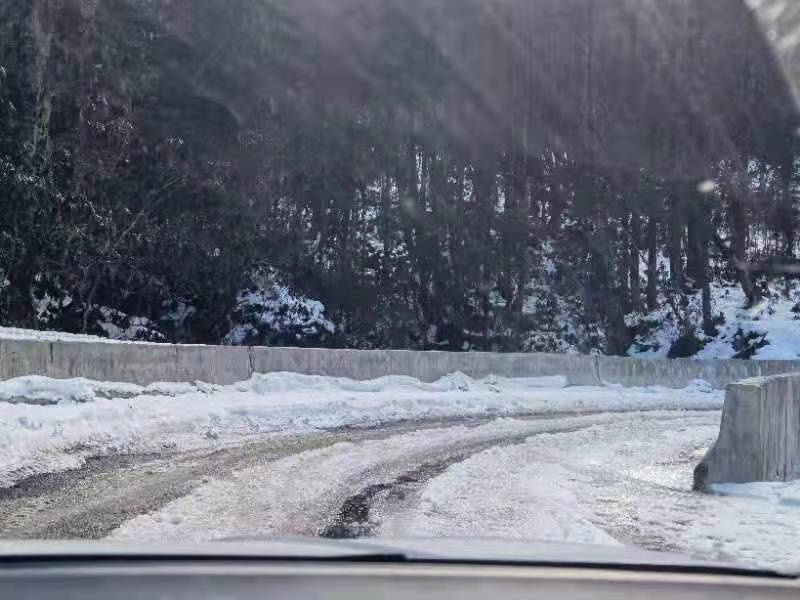
Back at the car, I seriously informed Ari of the situation she was facing, stating that if she didn’t want to continue on, we would turn around and head back. However, she simply said that if I decided to continue, she would come with me. Paul Solu, the great writer of travel literature, once said that travel is “when you put yourself in the hands of people you don’t know, even trusting them with your life.” At this moment, Ari, a strange girl whom I didn’t know two days ago, and who should never cross paths again, really put her life in my hands.
So, let’s go.
At first, the snowy section of road was quite smooth. When I turned a few sharp corners carefully and came to the section of the road that I thought was “snow-free”, I was dumbfounded: there was no white snow on the road, but what was left was a large smooth ice surface after the snow had melted halfway down. One of the sections was still flowing freely with raging meltwater from the snow-capped mountains.
As anyone knows, walking in snow and on ice are definitely two different experiences – even though you can be fit as a fiddle in the snow, if you don’t want to fall on your face, then don’t walk on the ice. And taking a car that weighs a ton and is only equipped with slick all-season tires onto ice is basically the same as subjecting it to random, irregular Brownian motion.
Subconsciously turning my head to look back, the thought of turning back flashed through my mind, but I soon realized that it was a delusion: the narrow, snow-covered road, which could only accommodate one car, had no chance of turning back once I had entered it.
(Sorry, no pictures here – we were both too scared for either of us to think about taking pictures)
“When driving on snow and ice, avoid jerking the direction and slamming on the accelerator and brakes; in the event of a sideslip, correct by slowly hitting the direction of the sideslip.” This rule, which every driver new to snow and ice driving has to memorize, was recited over and over in my mind. I’m sure no driver would want to practice any of it personally, especially when driving a vegetarian car without any ice equipment up such a steep cliff.
Fortunately, I eventually managed to ease the car over the ice without a hitch. During the short break and “celebration” that followed, I realized that the steering wheel was already sweaty from the grip.
The rest of the way, although still riddled with landslides and gushing water, we even waited for a long time at different repair work before we could pass, but nowhere was it as frightening as the previous “ice crossing”. As the elevation dropped, the road became flat and open, even passing an occasional pastoralist settlement with a curling smoke. This is the feeling of “coming back to earth”.

On 30 December 2020, three days after we completed the crossing, the Deqin-Gongshan Highway was closed again to all traffic. A major road repair and upgrading project followed, with an estimated reopening date of 1 April 2022. At the time of writing, the entire road was still closed.
6PM: Baihanluo, a night in a villager’s home
At a sharp bend on the way down, my phone navigation suddenly said, “Destination Baihanlo is on the left”. I looked to my left, but there was only a cliff covered with strange-shaped plants, as high as a wall.
This village of Baihanlo was supposed to be our last stop for the day. The map showed that it should be right behind “this wall”, but I was pretty sure that I didn’t have the power of a Laoshan Taoist to get through it. After meandering aimlessly several times, I realized that the only possible route was a narrow concrete road around the corner, hidden by dense trees and sloping to the sky, even though there were no signs at the intersection.
Tentatively following the trail, the car engine hissed up the steep slope, and as it rounded one sharp 180-degree bend after another and surged to the top of a slope that seemed to be in the clouds, a cozy village finally came into view, along with the church set against the snow-capped mountains of Pyro.

I first learned about Baihanluo and the church in the village from Mr. Qi’s exhibition. The Bai Hanluo church described in the information “incorporates more of the design language of Dali’s Jianchuan artisans than the church in Qi, with the Basilica-style Western architectural form cleverly blended with the Bai ‘double-stacked water’ style of Eastern architecture.” The Bai craftsmen of Jianchuan were once known far and wide, and in the days of timber-frame construction, hiring them to build either Buddhist temples or churches in the mountains of northwest Yunnan was almost the only option.
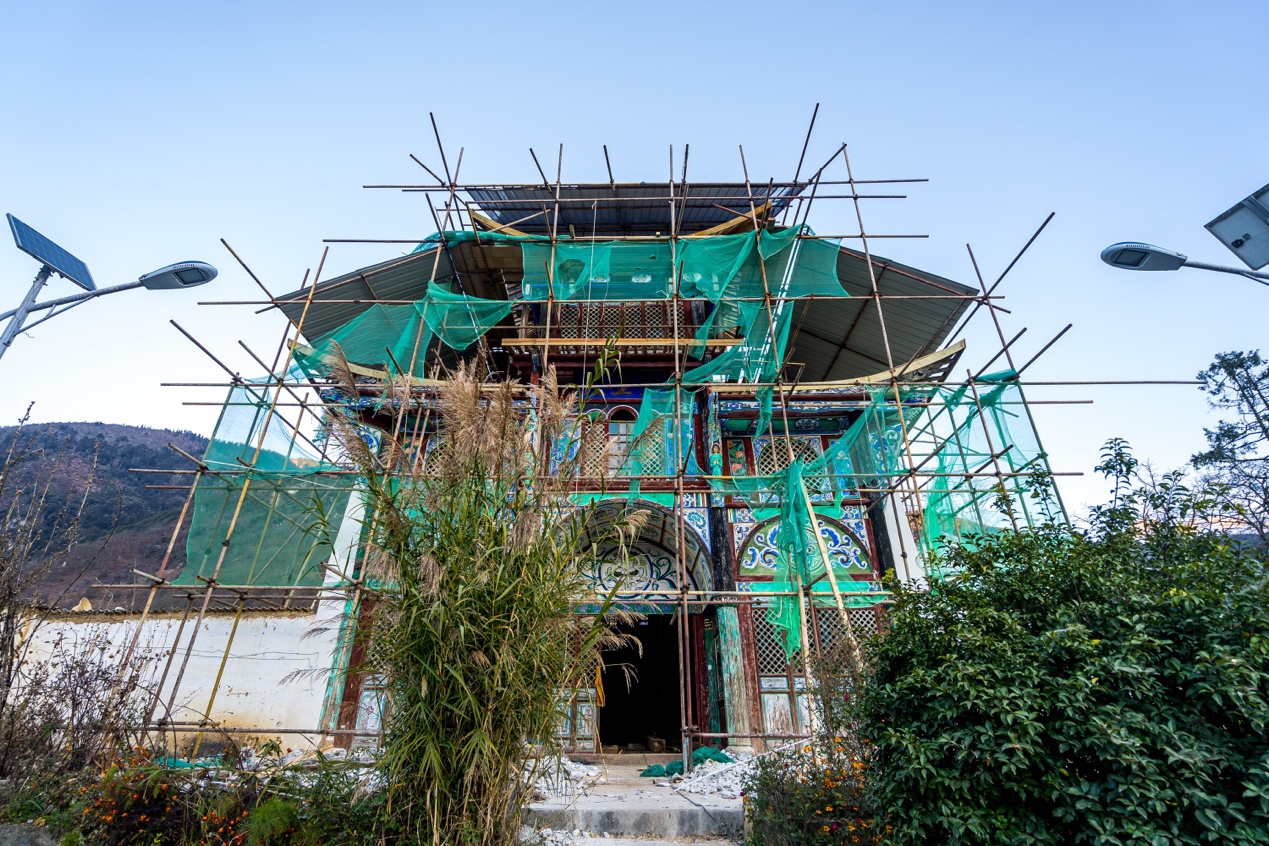
At the moment, the church is wrapped in scaffolding and green netting and seems to be undergoing a major restoration. However, perhaps because it was a weekend, there was no one around, but a cow of some sort roaming around unnoticed.
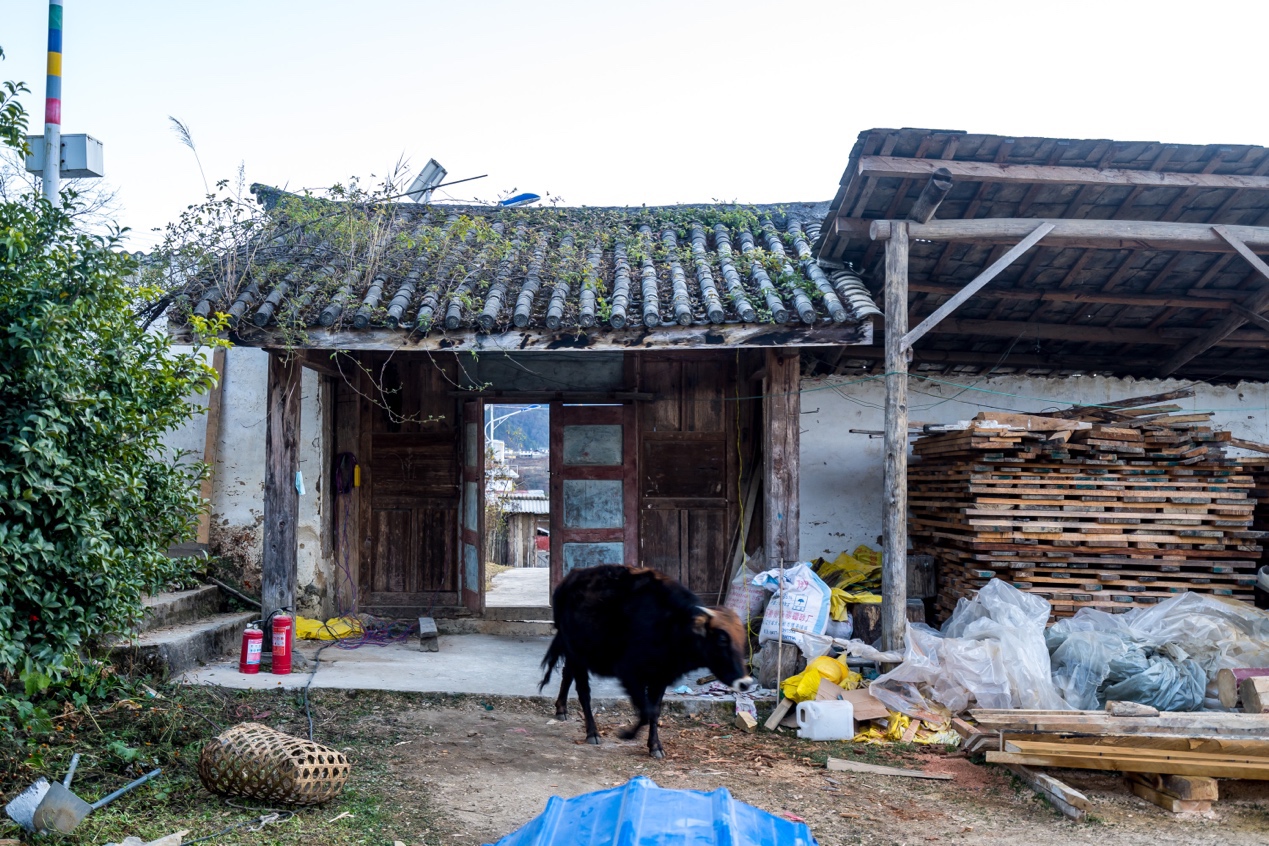
Through the gaps in the scaffolding, I noticed the intricately carved statue of Jesus on the beams. Compared to the church in Izaka, the Jesus here not only has the same “Chinese clouds” on his feet, but also has almost Chinese features. I was reminded of the controversial American TV show “Black Jesus”, and wondered if the Baihanluo’s Jesus would also drink ghee tea and be offered a hada by the faithful. In any case, in those days when there was no internet, it would have been more difficult for a craftsman in the mountains to imagine what the Jewish Jesus looked like out of thin air than for him to make the wood carving itself.

Inside, the roof is a Bai-style grid of algae wells, and the decorative motifs painted on them are a blend of East and West, including various images of crosses and the traditional Chinese “auspiciousness” motif. The wall murals show grapevines wrapped around a cross, a reference to the Chinese saying “grapes are blessed with many children” or a thank you to the missionaries for bringing grapes and wine to the area. What I find most amazing is that the designers have cleverly incorporated the stained glass window elements that are common in Western churches into the Chinese window panes of the building itself.
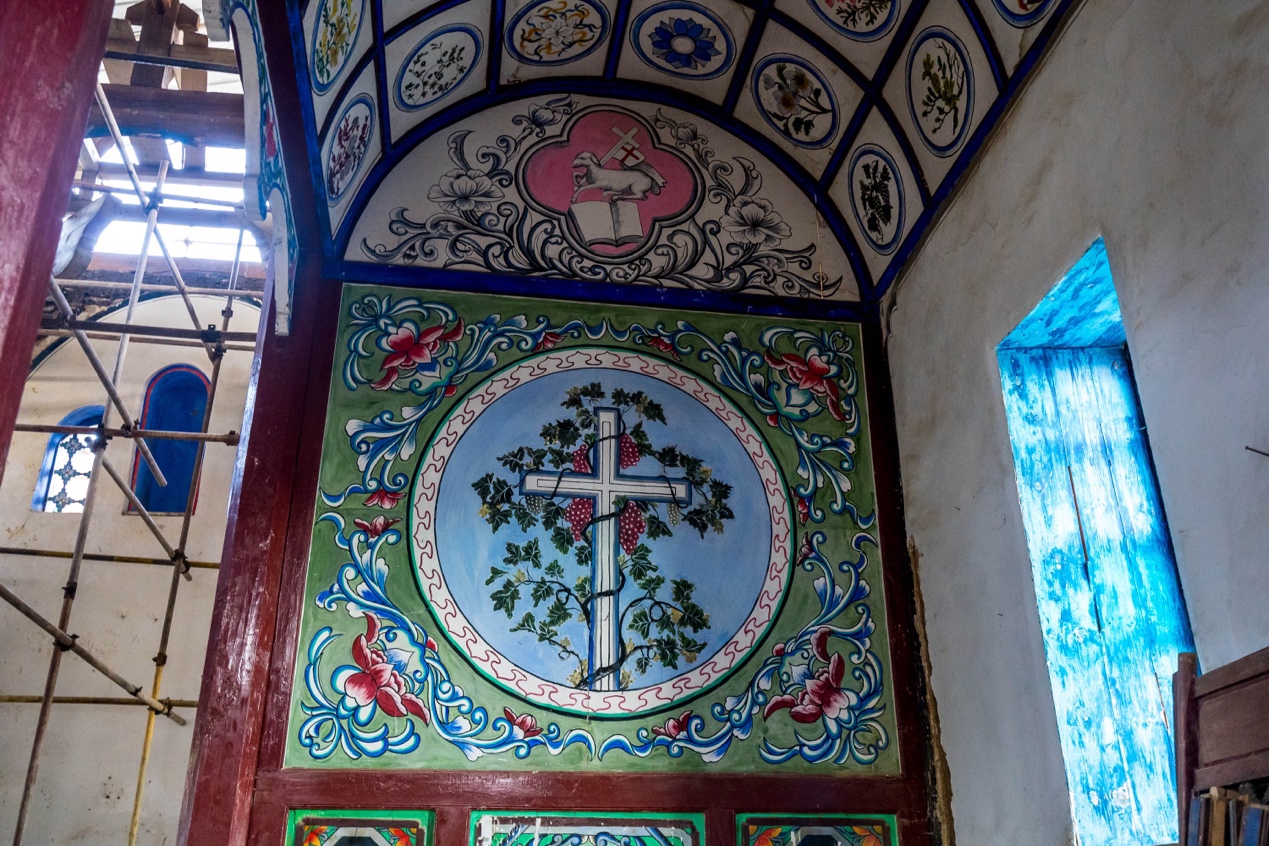
Through a friend from the church, Ari contacted Gachin, the director of the church in Baihanlo. He was already waiting for us at the door when we came out of the church. This young man, in his thirties, is also the person currently in charge of this repair project.
Baihanlo is a mixed multi-ethnic village. Each of its inhabitants possesses two different dimensions of identity: Tibetan or Nu; Buddhist or Catholic. For example, Gachen’s full name is Gachen Jiabi’e’er, a common Tibetan given name with the Chinese translation of the archangel Gabriel in the Bible.
The history of beliefs of the inhabitants of the northern Nujiang River, where Gongshan is located, is more complex than that of Deqin. The Nu people were the first indigenous people here, initially believing in the primitive religion of Animism and relying on shamans, or Nanmusha, as a bridge to the spirits. About two hundred years ago, lamas from Sichuan province entered Gongshan for the first time to spread Tibetan Buddhism, gradually bringing them their first faith transformation amidst the local people’s disbelief and questions.
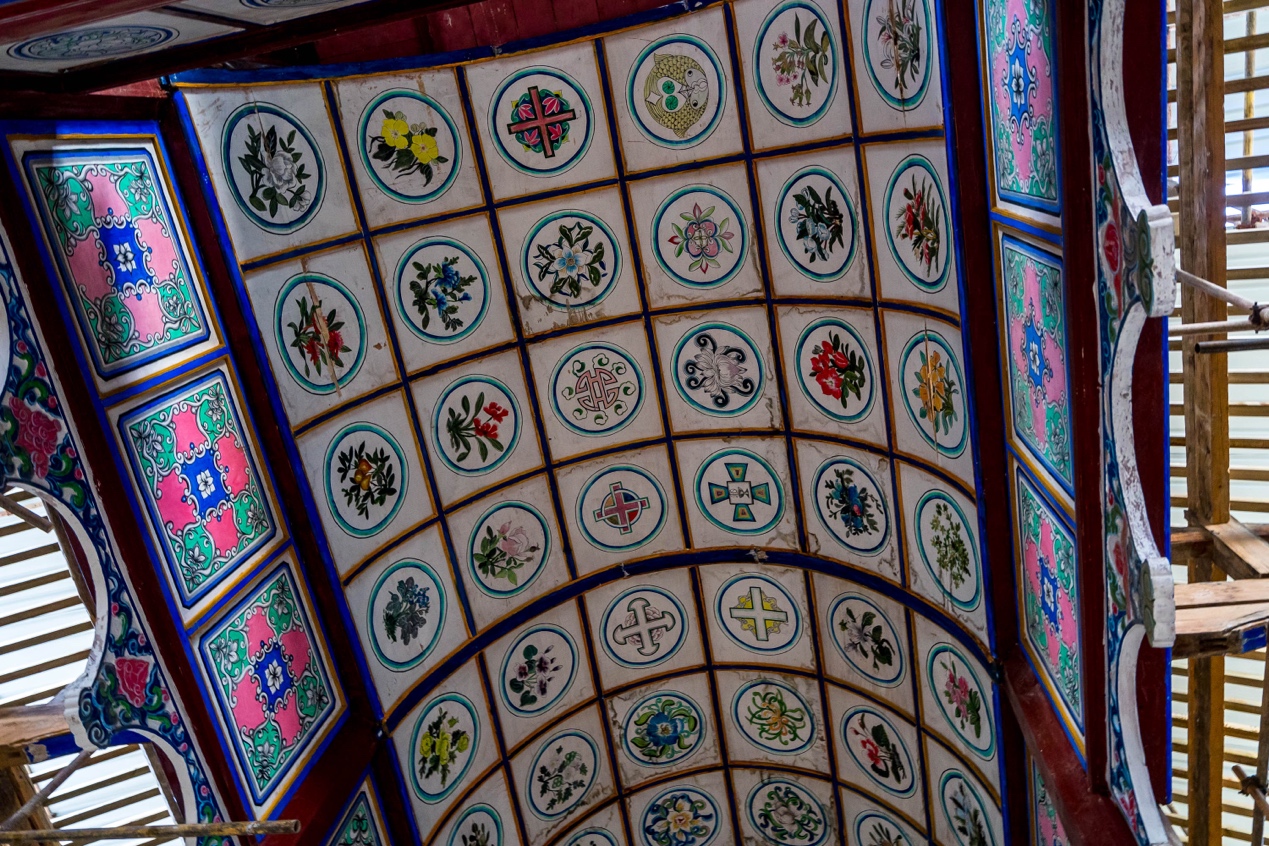
The Catholic faith here, similar to that of Deqin, also originated from the French missionaries a century ago. Also similar to Deqin is the 1905 anti-missionary riot. The first church in Baihanluo was built in 1898 and the present one was rebuilt after the old one was burnt down in 1905.
Hearing that we hadn’t had dinner and hadn’t booked a place to stay that night, Gajin immediately invited us to stay at his house.
“Is this …… convenient for you?” I was a little hesitant at this sudden kindness, fearing that I might go forward hastily but give them too much trouble.
“Of course it’s convenient.” He replied dryly, “The house is big and empty anyway.”
I have to accept then.
He took us to the kitchen of the house. It was a round wooden bungalow, like a Russian Izba. The walls were scorched and blackened from years of smoke and fire. The fire pit was propped up in one corner of the room, emitting a pleasant warmth. On the wall next to it, there is air-dried bacon, which is very appetizing.
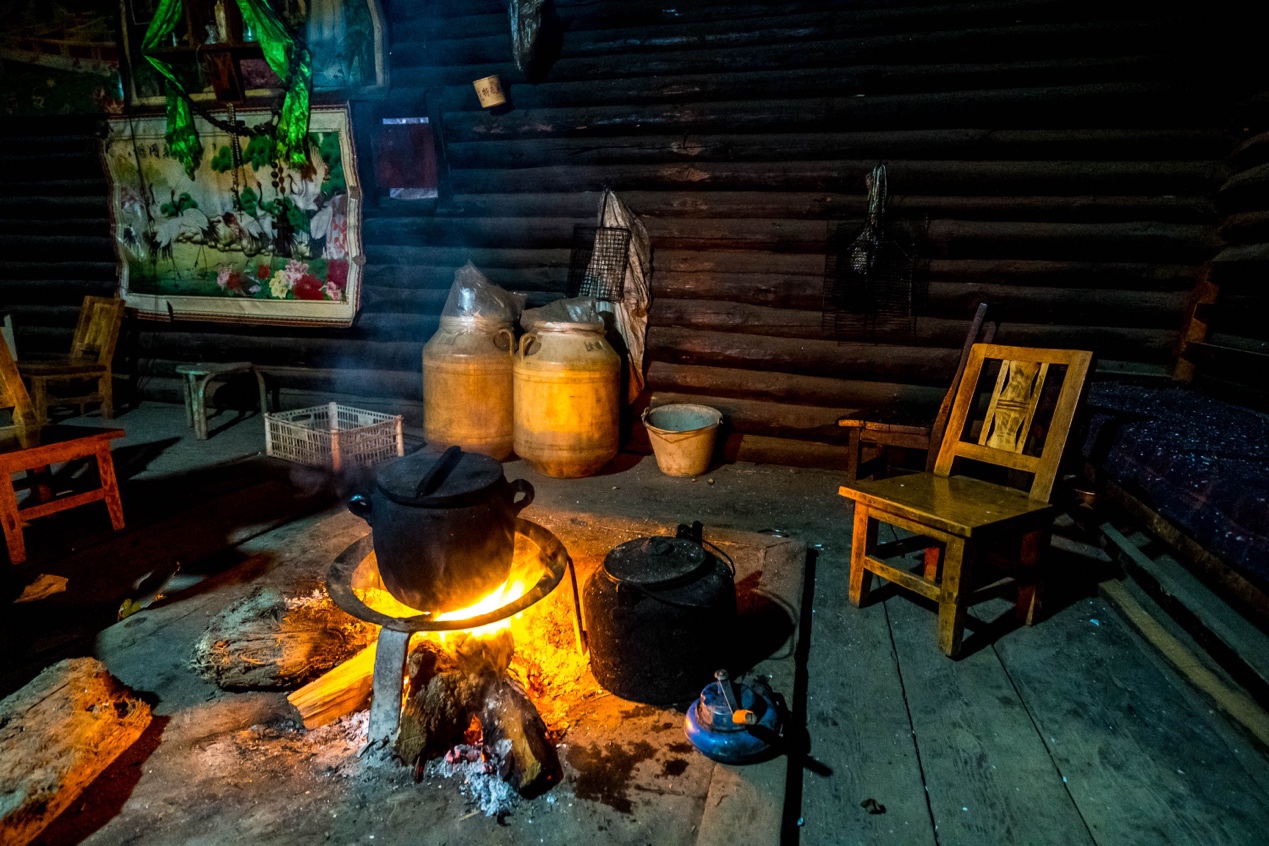
Also hanging on the wall, the wooden shrine, a symbol of faith, has four or five statues or paintings of Jesus inside and out, all still benevolent. The entire shrine is covered by a green hada, which in Tibetan culture represents the river, a symbol of reproduction and fertility.
The family used to live in a similar wooden house, with people living upstairs and livestock downstairs, Ghazen said. And after the new house next door was built a few years ago, the log cabin was used only as a kitchen and dining room. Also built only in the past few years is the rugged narrow road into the village just now – before it, the only way for villagers to get in and out was to climb up the steep cliff face for three hours, carrying bamboo baskets on their backs.
As he described the village, he skillfully added wood to the fire, and the heavy smell of smoke and fire gradually filled the room. Ghajin’s wife brought in a pot and knelt down by the fire to begin preparing dinner.
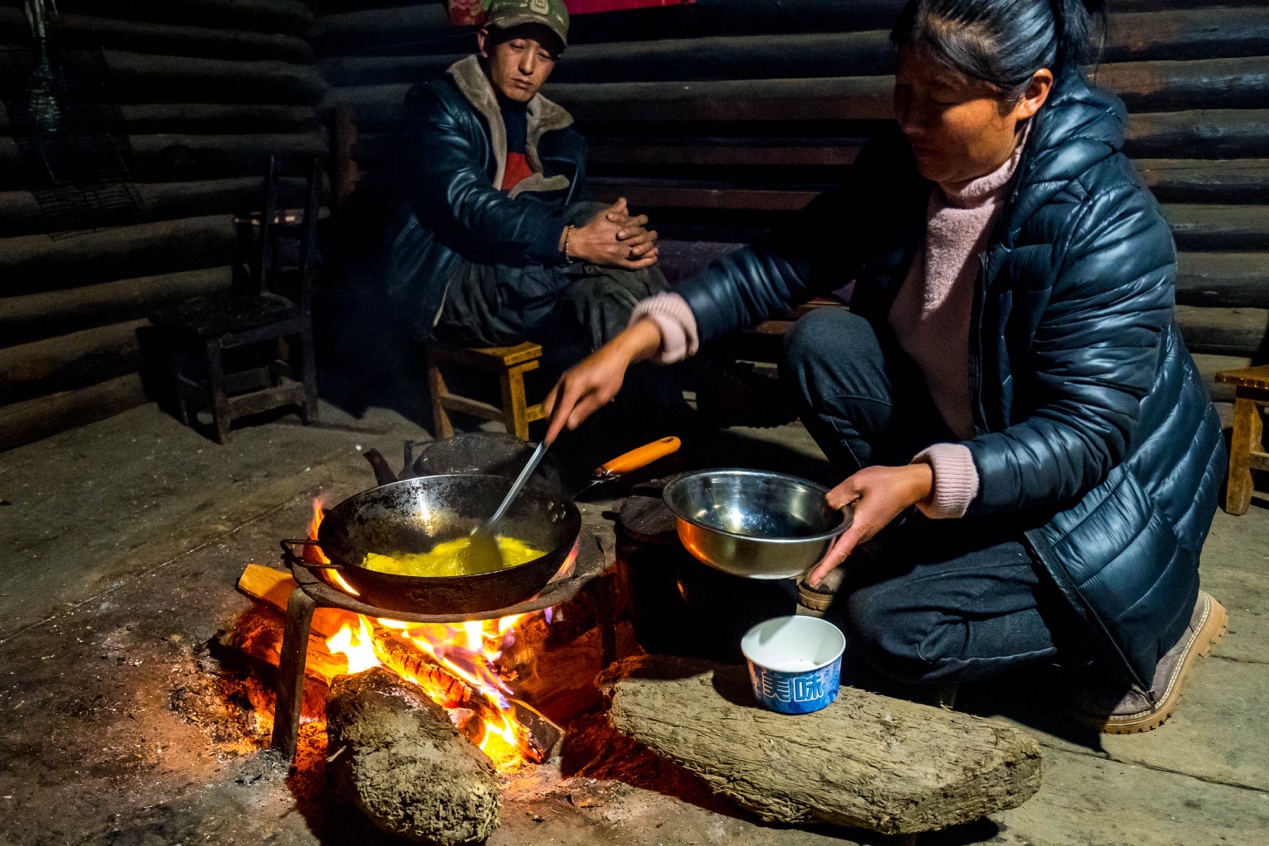
Dry-fried cabbage, spicy fried taro slices, and roasted pork with winter melon, soon three tempting home-cooked dishes were put on the table one after another. Seeing that only two sets of bowls and chopsticks were served, I realized that they had already eaten, and that all three dishes had been made especially for the two of us.

Ari said a pre-dinner prayer, thanking the Lord for the food. And all I could do was to turn my head and say thank you to Mr. and Mrs. Garzen who were busy scrubbing pots and pans and washing dishes, thanking the unreserved kindness from strangers.
Every evening at 7:30 pm, the village vespers begin promptly. This is a custom that has continued for a hundred years and has never been interrupted except for a few special years. The long absence of a priest from the Baihanlo church made it impossible to hold regular Masses, and Vespers, which was never missed, became the most important regular gathering of the Catholic faithful in the village.
Because the church was being renovated, evening prayers were held in a makeshift prayer house next to the church. When we arrived, a dozen people were already gathered in the dimly lit hut, mostly middle-aged and elderly people who had stayed behind in the village. The walls around the hut were surrounded by multicolored hakodes and cartoon Santa Claus hangings.

The prayer is the common Catholic Rosary. It was originally French missionaries who translated this complex hymn into Tibetan and have sung it in the mountains to this day. Although Baihanlo has two ethnic groups, Tibetan and Nu, the village’s Nu ethnic group has also long since embraced Tibetan culture and is distinguished from the Tibetans only by their identity cards.
Evening prayer lasts about 40 minutes, with participants sitting, then standing, then kneeling, as the melodious singing echoes through the small wooden room. No one leads the prayers, and everyone knows the process by heart, as if it has already become part of their bodies. The tune is similar to the lyrics and is purely Tibetan in style, and if it weren’t for the occasional “Hail Mary” in Chinese, I wouldn’t even be able to distinguish it from Tibetan Buddhist music.

To me, this Tibetan tune, chanted by the faithful of two ethnic groups, this Catholic hymn, a mixture of two languages, can hardly be described as Catholic, Tibetan, Nuer, or Han, but rather as a great blend of all of the above.
Like the dengbêj I heard in the ancient city of Diyarbakır in Turkey, it is an equally lilting chant, a national epic that has been passed down orally from the local Kurdish people to this day. This ancient nomadic people, who have lived on the edge of the Anatolian plateau for generations, converted to Islam a thousand years ago and then had the land they inhabited divided among four neighboring countries at will by the colonizers a century ago.
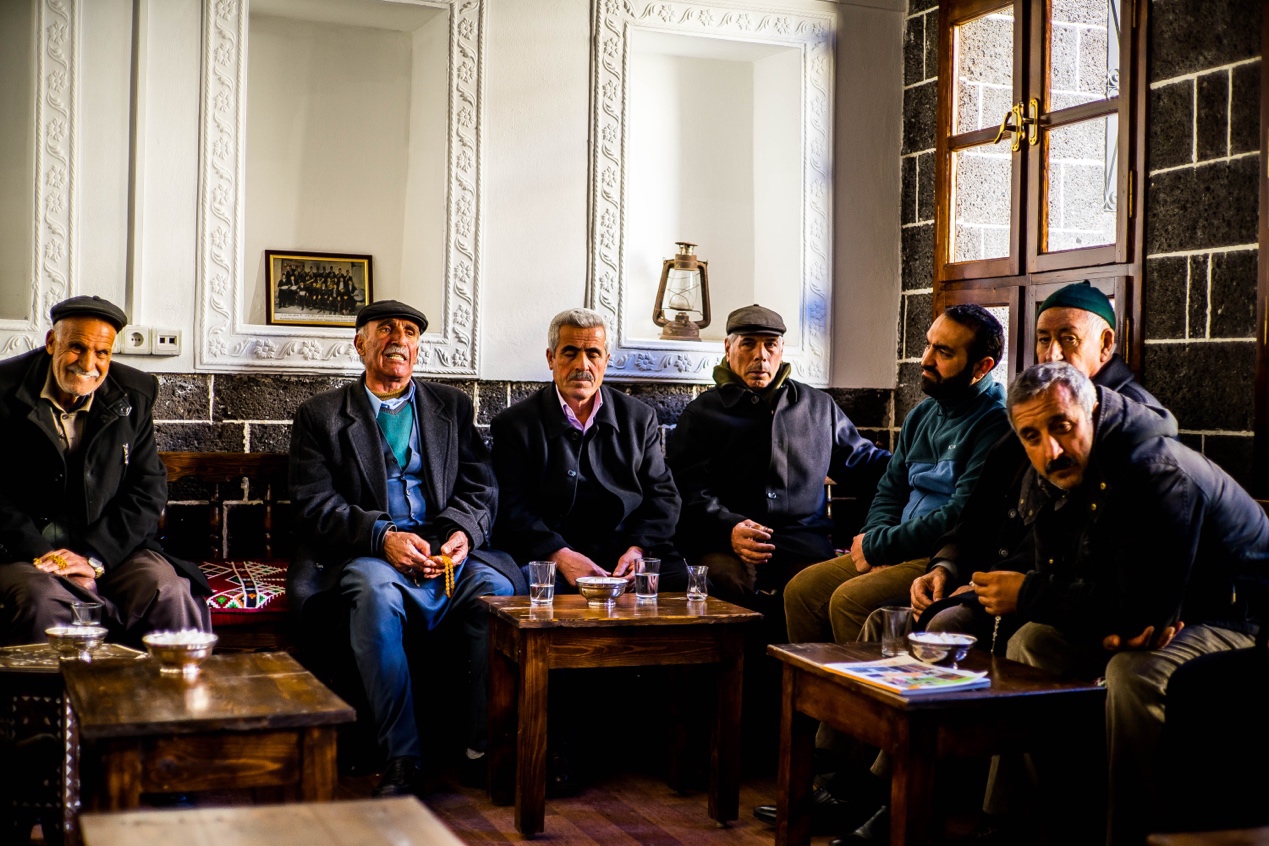
I asked the old man who was singing, “Which do you feel best represents your identity, Kurdish, Muslim, or Turkish citizen?”
“All three.” Through the young interpreter, he told me.
When I returned to Gachin’s house, there was another person by the fire: Lao Dai, a member of the poverty alleviation team who had come to stay temporarily in the village.
The old generation originally operated an inn in Dali, due to the impact of the epidemic, business in 2020 is not as good as before. He wanted to do something, so he signed up for the “technical poverty alleviation task force”, as an information entry clerk to Dali counterparts to help Gongshan County, lived in the deep mountains of the Gachin family.
The team mainly teaches Chinese language and hand weaving skills to the locals, and not only is it completely free of charge, but participants also receive a free lunch and a grant. According to Lao Dai, the villagers are highly motivated to participate.
Seeing us talking, Ghajin served red wine in paper cups, “It’s made in the village, so feel free to try it.” With that, he joined the conversation. This was the first time I had ever tasted local wine, and I asked Gachin where the winemaking process came from. He said it was handed down from his ancestors, and the earliest does date back to the missionaries who came here a hundred years ago.
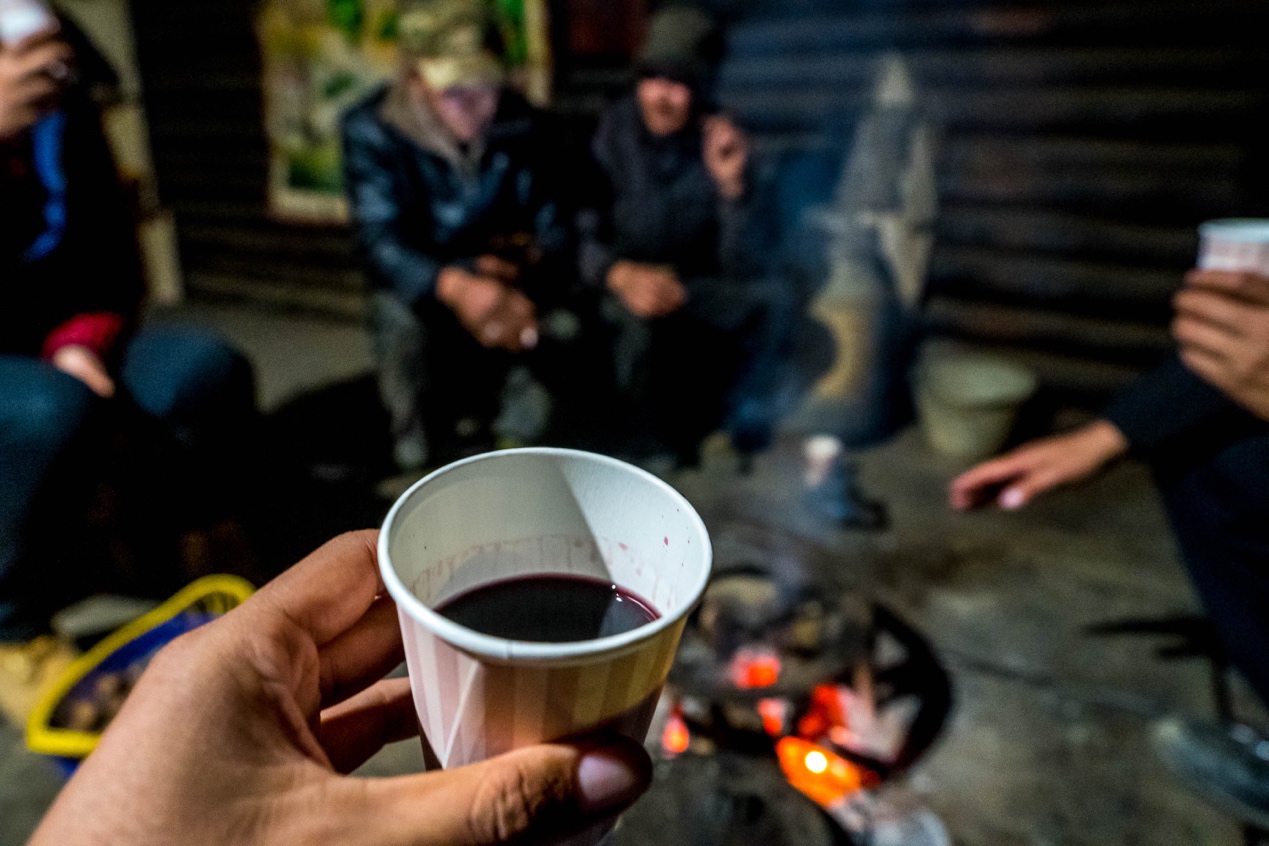
A sip of the wine is refreshing and sweet, with a slight aroma of the earth of the plateau, as described in the book, “the best wine of the Rhine”.
Good wine and good friends are always an irresistible warmth to the heart. Before I knew it, a few glasses were downed and soon a mix of slight inebriation and drowsiness hit me. I realized that I had already experienced too many stories in this short day.
Garjin’s wife found two separate rooms in the new house for Ari and I to spend the night in, and an exhausted me soon fell into sleep. It wasn’t until I woke up the next day that I had the energy to notice what was in front of me. This room belonged to Gachin’s son who was boarding at Dimaro Primary School down the hill, and on the wall was the boy’s award for winning both the basketball and rope skipping titles in the school sports day. I stepped out of the room, the door facing the wide terrace on the second floor, the snow-capped mountains in the distance reflecting the first rays of the morning sun.
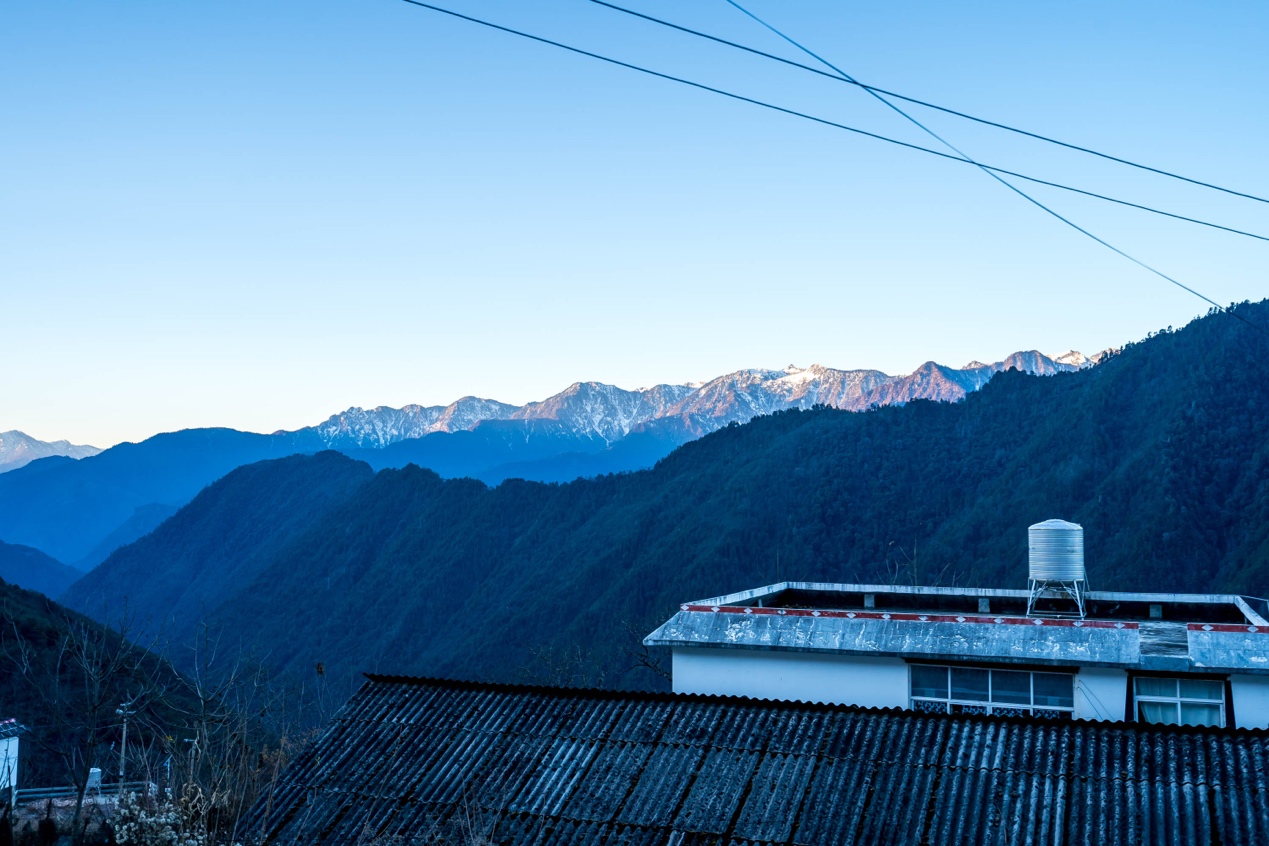
When I went to breakfast, Gachin’s wife had already cooked aromatic ghee tea. On the way here, I noticed various livestock and poultry such as chickens, ducks and cows gathered around the wooden house and thus asked.
“The new house is huge, it must have a dozen rooms, right? You guys are doing pretty good in the farming business!”
“Where where where, the house was built by the government, how could we build such a big one!”
She looked a little embarrassed as she said this.
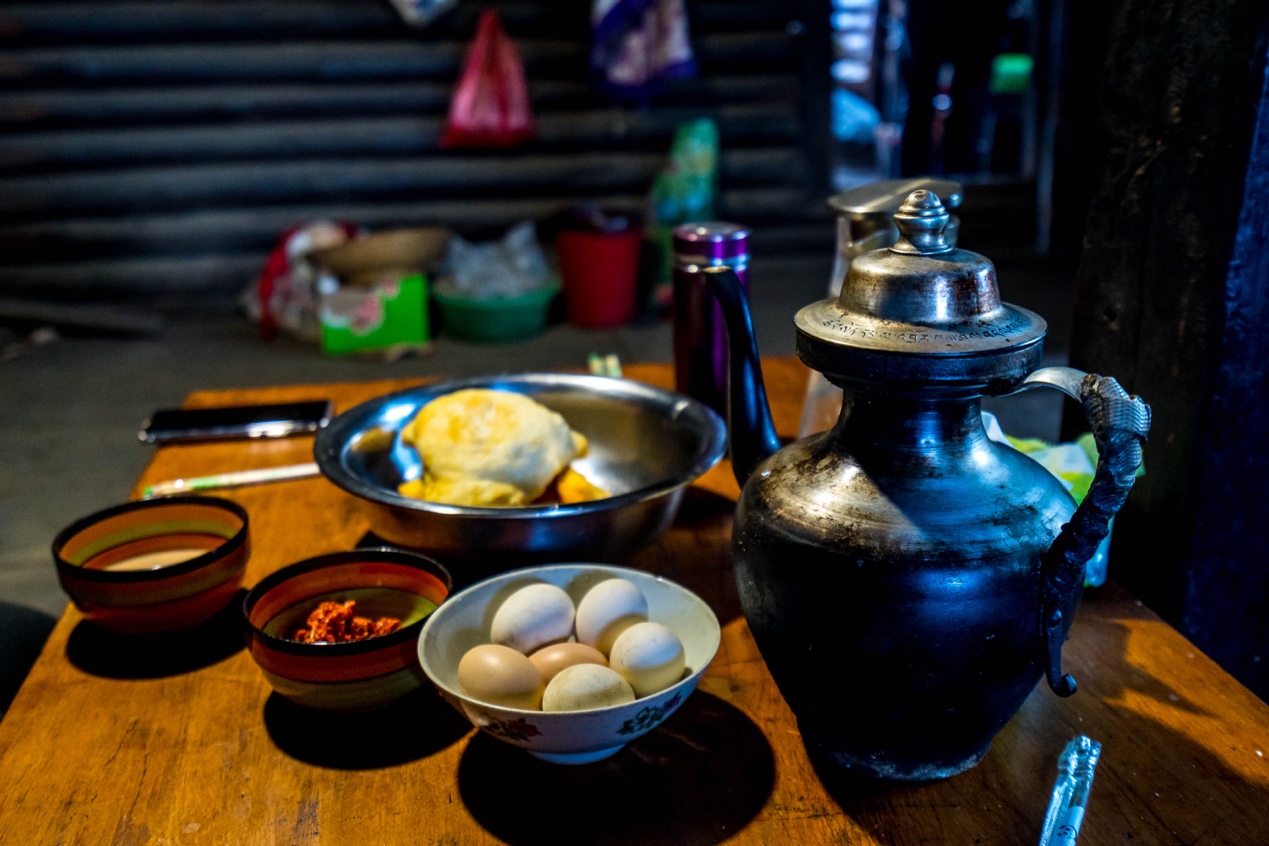
After bidding farewell to the Gachins, we drove down the same road we had come from and continued along the Drikung Highway, with the Nu River just a short distance ahead. The Lonely Planet guide says it’s a secret place where “man and god live together”. And yet I had already made so many unforgettable memories along the way before we even got there, even in just 24 hours. It’s hard to imagine how many more unforeseen stories await ahead.

